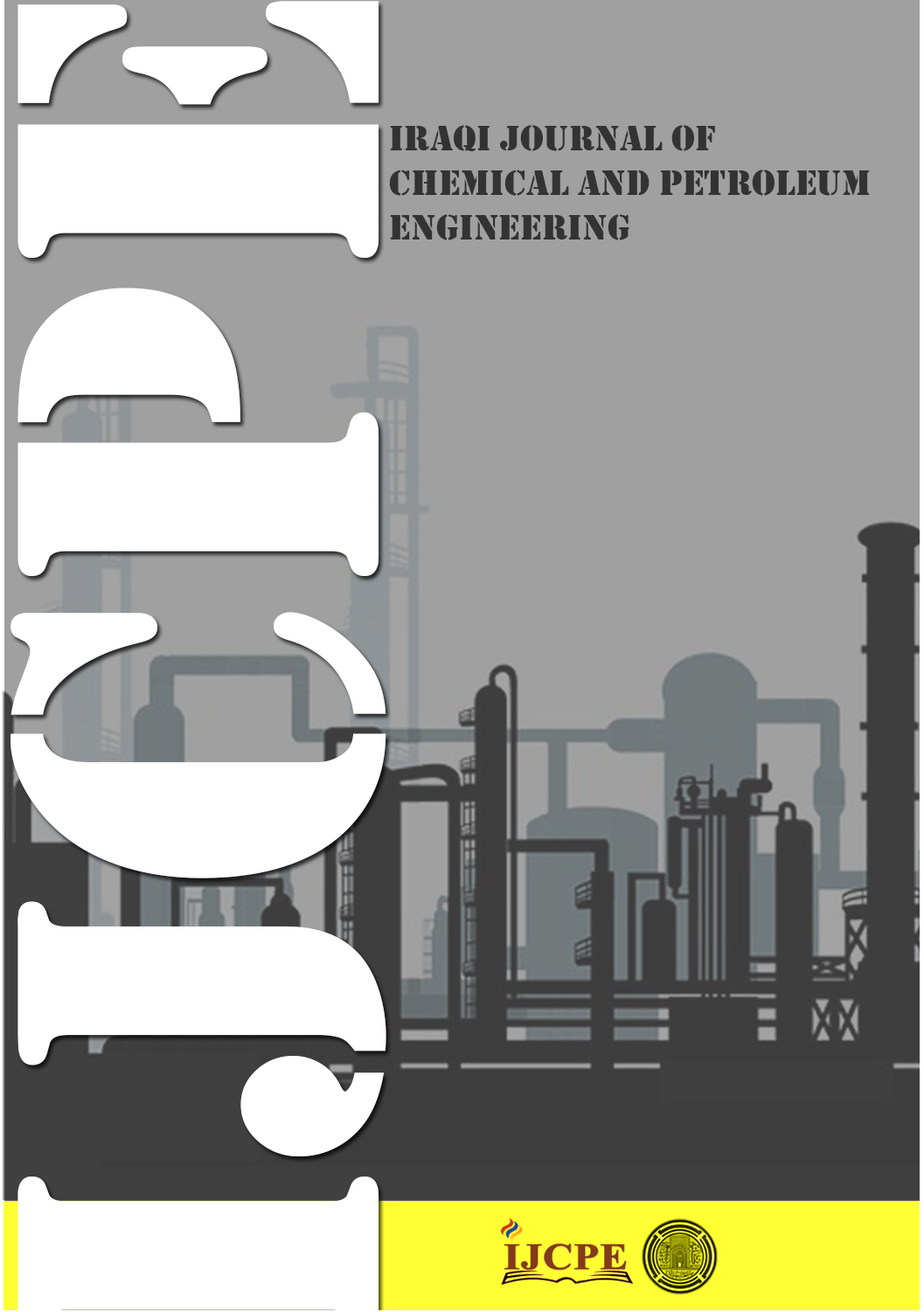Oxidation desulfurization of model oil using carbon composite derived from peach stone waste
DOI:
https://doi.org/10.31699/IJCPE.2025.3.15Keywords:
Activated carbon; ZrO2; simulated oil; oxidation desulfurization; DibenzothiopheneAbstract
In this study, oxidative desulfurization of dibenzothiophene (DBT) with H2O2 as an oxidant was studied, whereas the catalyst used was zirconium oxide supported on Activated carbon (AC). Zirconium oxide (ZrO2) was impregnated over prepared activated carbon (AC) and characterized by various techniques such as XRD, FTIR, BET, SEM, and EDX. This composite was used as a heterogeneous catalyst for oxidation desulfurization of simulated oil. The results of this study showed that ZrO2/AC composite exhibited significant catalytic activity and stability, effectively lowering sulfur content under mild conditions. Factors such as reaction temperature (30, 40, 50, 60°C), time (5, 10, 15,20,30,60, 80 100 min), catalyst dose (0.3, 0.5, 0.7, 0.9 g) and initial concentration of dibenzothiophene (DBT) (20,40, 60, 80, 100, 200, 300 ppm) was used to achieved maximum efficiency. 10 ml of H2O2 /100 ml of simulated oil was used as an oxidizing agent. It was found that an increase in all the above variables led to an increase in desulfurization efficiency, except for an increase in initial DBT concentration, which led to a decrease in removal efficiency. The maximum removal efficiency of sulfur content was 92.22%, which was achieved at 60 °C and 0.9g of composite /100 ml of simulated oil at equilibrium time 100 min and 100ppm initial concentration of DBT. Finally, the reaction kinetics matched the pseudo-second order rate model, with an activation energy of 36.665 KJ/mol.
Received on 27/10/2024
Received in Revised Form on 17/01/2025
Accepted on 17/01/2025
Published on 30/09/2025
References
[1] T. A. Jalal and L. F. Hasan, “oxidative desulfurization of gasoil using improving selectivity for active carbon of rice husk”, Diyala Journal For Pure Science, vol:8, no. 3, 2012.
[2] A.T. Nawaf and B. A. Abdulmajeed, “Design of oscillatory helical baffled reactor and dual functional mesoporous catalyst for oxidative desulfurization of real diesel fuel”, Chemical Engineering Research and Design, vol. 209, pp.193-209, 2024. http://doi.org/10.1016/j.cherd.2024.07.032
[3] N. M. Abdullah, H. Q. Hussien, and R. R. Jalil, “Heavy Naphtha Desulfurization by ozone generated via the DBD plasma reactor” Iraqi Journal of Chemical and Petroleum Engineering , vol.25 no. 2 pp.131-137, 2024. https://doi.org/10.31699/IJCPE.2024.2.12
[4] S. H. Ammar and S. A. Jaafar “Adsorption kinetic and isotherms studies of thiophene removal from model fuel on activated carbon supported copper oxide”. Iraqi Journal of Chemical and Petroleum Engineering, vol.18, no.2, pp. 83-93, 2017. https://doi.org/10.31699/IJCPE.2017.2.7
[5] N. S. Ahmed Zeki, S. M. Ali, and S. R. Al-Karkhi “Investigation desulfurization method using air and zinc oxide/ activated carbon composite”. Iraqi Journal of Chemical and Petroleum Engineering, vol.18, no.1, pp. 37-46, 2017. https://doi.org/10.31699/IJCPE.2017.1.3
[6] G. Zhang, F. Yu, and R. Wang, “Research advances in oxidative desulfurization technologies for the production of low sulfur fuel oils”, Petroleum And Coal, 51(3) 196-207, 2009.
[7] L. Xiong, X. M. Yan, and P. Mei,. “Synthesis and characterization of a ZrO2/AC composite as a novel adsorbent for dibenzothiophene”. Adsorption Science and Technology, vol. 28 no. 4, pp.314-350, 2010. https://doi.org/10.1260/0263-6174.28.4.341
[8] Y. Li, X. Tang, S. Niu, Y. Wang, K. Han, and C. Lu, . “synthesis of the zirconium dioxide activated carbon based heterogeneous acid catalyst to catalyze esterification for biodiesel production with molecular simulation”, Biomass Conversion And Biorefinery, vol.13(17), 2023. https://doi.org/10.1007/s13399-021-02105-5
[9] Z. Hassan, D. O. Cho, I. H. Nam, C. M. Chon, and H. Song,” Preparation of calcined zirconia-carbon composite from metal organic frameworks and its application to adsorption of crystal violet and salicylic acid”, Materials, vol.9, 261, 2016. https://doi.org/10.3390/ma9040261
[10] A. Elmouwahidi, E. B. Garcia, A. F.P Cadenas., F. J. M. Hodar. , J. C. Quiben, and F. C. Marin. “Electrochemical performances of supercapacitors from carbon-ZrO2 composite”, Electrochimica Acta, vol. 259, pp.803-814, 2018. https://doi.org/10.1016/j.electacta.2017.11.041
[11] V. Gurung, B. Pokharel et al., “Characterization of activated carbon prepared from peach seed stone by chemical activation with zinc chloride (ZnCl2)”, Proceeding of IOE Graduate Conference, vol.7, pp.59-64, 2019.
[12] R. Kandulna, R. B. Choudhary. “Concentration-dependent behaviors of ZnO-reinforced PVA-ZnO nanocomposites as electron transport materials for OLED application”, Polymer Bulletin, vol. 75, 2018. https://doi.org/10.1007/s00289-017-2186-9
[13] K. Krishnamoorthy, S. Natarajan, S. Kim, and J. Kadarkaraithangam, “Enhancement in thermal and tensile properties of ZrO2/poly (vinyl alcohol) nanocomposite film”, Materials Express, vol.1, no. 4, 2011. https://doi.org/10.1166/mex.2011.1036
[14] S. Ding, J. Zhao, and Q. Yu. “Effect of zirconia polymorph on vapor phase ketonization of propionic acid”. Catalysts, vol.9, p.768, 2019. https://doi.org/10.3390/catal9090768
[15] A. S. Yasin, M. Obaid, I. M. A. Mohamed, A. Yousef, and N. A. M. Barakat. “ZrO2 nanofibers/AC composite as a novel and effective electrode material for the enhancement of capacitive deionization performance”. RSC Advances, vol.7, 4616, 2017. https://doi.org/10.1039/c6ra26039j
[16] H. A. Ahsaine, Z. Anfar, M. Zbair, M. Ezahri, and N. El Alem. “Adsorption removal of methylene blue and crystal violet onto micro-mesoporous Zr3O/Activated carbon composite: a joint experimental and statistical modeling considerations” Journal of Chemistry. 2018. https://doi.org/10.1155/2018/6982014
[17] M. Thommes, K. Kaneko, A. V. Neimark, J. P. Olivier, F. R. Reinoso, J. Rouquerol, and K. S. W. Sing, . “Physisorption of gases, with special reference to the evaluation of surface area and pore size distribution (IUPAC technical report). Pure Appllied Chemistry, vol. 87, no. 9-10, pp.1051-1069, 2015. https://doi.org/10.1515/pac-2014-1117
[18] P. Praveen, G. Viruthagiri, S. Mugundan, and N. Shanmugam, “structural and optical and morphological analyses of pristine titanium di-oxide nanoparticals-synthesized via sol-gel route”, Spectrochimica Acta Part A: Molecular And Biomolecular Spectroscopy, vol.117, pp. 622-629, 2014. https://dx.doi.org/10.1016/j.saa.2013.09.037
[19] P. N. Chuc et al. “Highly efficient adsorption of arsenite from aqueous by zirconia modified activated carbon”. Environmental Engineering Research vol. 29(2), 2024. https://doi.org/10.4491/eer.2023.076
[20] B. C. Smith. “The carbonyl group, part V: carboxylates- coming clean”. Spectroscopy, vol. 33 pp. 20-23, 2018.
[21] A. B. D. Nandiyanto, R. Oktiani, and R. Ragadhita. “How to read and interpret FTIR spectroscope of organic material”. Indonesian Journal of Science & Technology, vol.4(1) pp.97-118, 2019.
[22] H. S. Mansur, C. M. Sadahira, A. N. Souza, A. A. P. Mansur. “FTIR spectroscopy characterization of polyvinyl alcohol hydrogel with different hydrolysis degrees and chemically crosslinked with glutaraldehyde”. Material Science And Engineering, vol.28, pp. 539-548, 2008. https://doi.org/10.1016/j.msec.2007.10.088
[23] N. F. M. Suhaimi, S. A. Kamil, and M. K. Abd Rahman, “morphological, structural, and photoluminescence properties of Er+3 doped SiO2-ZrO2/PVA nanofiber”. Journal of Engineering and Science and Technology, vol.18, pp. 437-452, 2023.
[24] S. Beshkoofeh, B. G. Choobar, and Z. Shahidian, “Optimization of the oxidative desulfurization process of light cycle oil with NiMo/y Al2O3 catalyst”. Physical Chemistry Research, vol.10, no.1, pp. 57-67, 2022. https://doi.org/10.22036/PCR.2021.285150.1917
[25] X. Zhang, Y. Zhu, Q. Han, X. MA, P. Chen Z., Zhao, and Q. Wang, “ Pd (CH3COOH)2 and MIL-101 (Cr) composites: A novel in-situ oxidation catalyst for the removal of BT from fuel oil under natural condition”, IOS Press Ebooks, vol.22, pp.331-339, 2022. https://doi.org/10.3233/ATDE220245
[26] A. E. S. Choi, S. Roces, N. Dugos, and M.W. Wan, “Mixing-assisted oxidative desulfurization of model sulfur compounds using polyoxometalate/H2O catalytic system”, Sustainable Environment Research, vol. 26, pp.184-190, 2016. https://doi.org/10.1016/j.serj.2015.11.005
[27] P. Huang, G. Luo, L. Kang, M. Zhu, and B. Dai, “Preparation, characterization and catalytic performance of HPW/aEVM catalyst on oxidative desulfurization”, RSC Advances, vol. 7, pp. 4681-4687, 2017. https://doi.org/10.1039/C6RA26587A
[28] H. H. Alwan, A. A. Ali, and H. F. Makki, “Optimization of oxidative desulfurization reaction with Fe2O3 catalyst supported on graphene using box-behnken experimental method”, Bulletin of Chemical Reaction Engineering and Catalysis, vol. 15, pp.175-185, 2020. https://doi.org/10.9767/bcrec.15.1.6670.175-185
Downloads
Published
Issue
Section
License
Copyright (c) 2025 The Author(s). Published by College of Engineering, University of Baghdad.

This work is licensed under a Creative Commons Attribution 4.0 International License.













